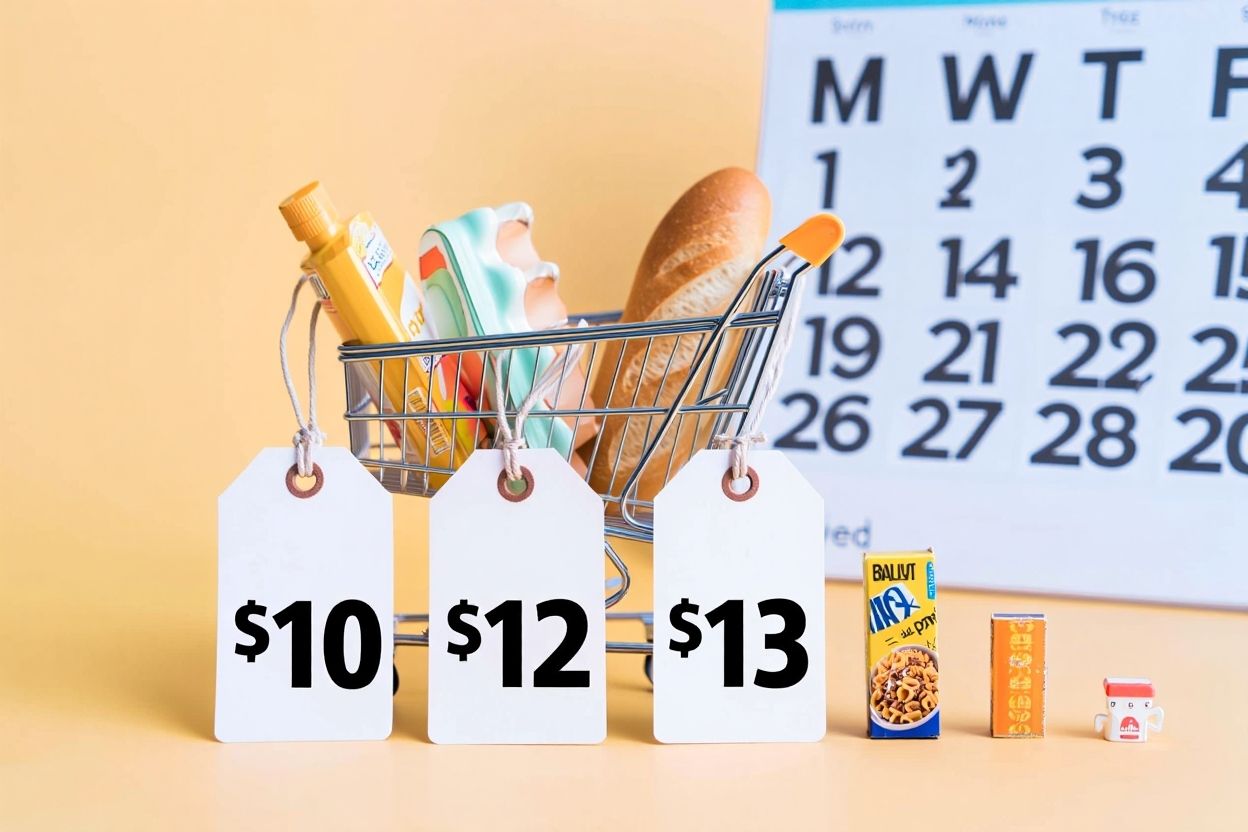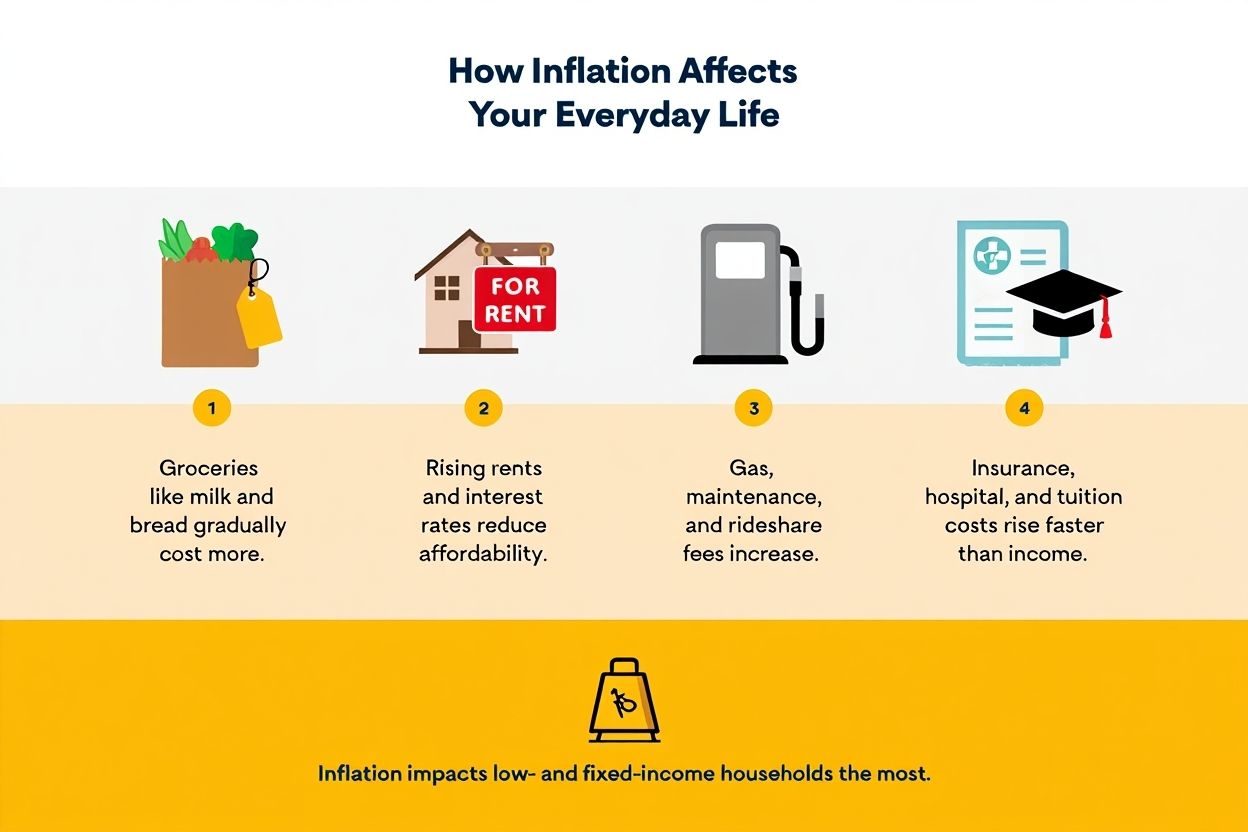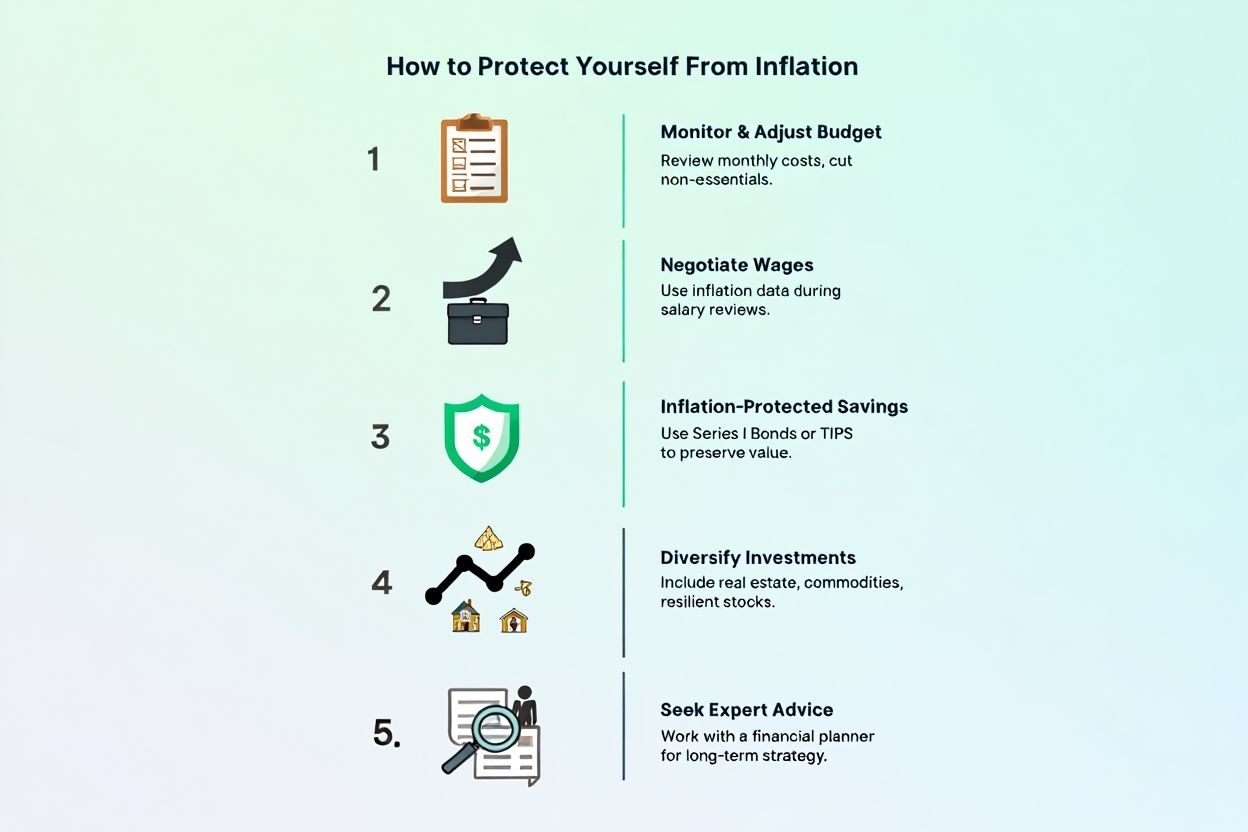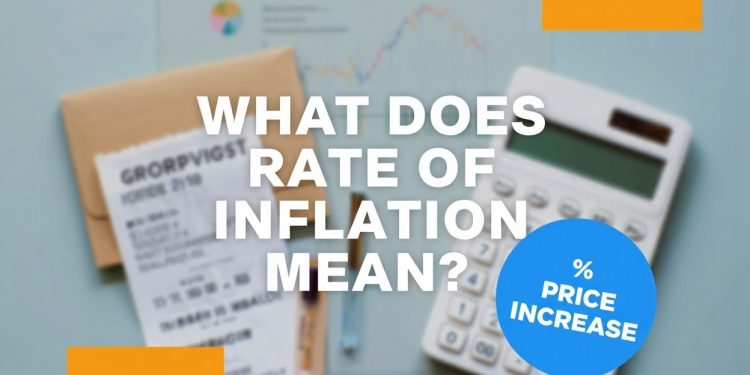What does rate of inflation mean? Inflation touches nearly every part of our daily lives , from the price of groceries and rent to savings and wages. It affects how much you pay for goods, how far your paycheck stretches, and the value of your investments.
Simply hearing the word inflation is common, but knowing what does rate of inflation mean is key to understanding its impact. This rate shows how quickly prices rise over time and influences important economic decisions, including spending, saving, and planning for the future.
In this article, we will explain what the rate of inflation means, why it matters, and how you can use this knowledge in practical ways. First, let’s start by defining inflation itself.
1. What does rate of inflation mean?
The rate of inflation is the percentage at which the average prices of goods and services increase over a specific period, usually a year.

For example, if prices are 3% higher this year than last year, the inflation rate is 3%. This means your money’s value has dropped, and you need more cash to buy the same items as before.
Understanding what does rate of inflation mean helps you see how fast prices are rising and how inflation influences everything from rent to groceries and fuel.
Let’s break it down further with key facts and practical examples.
1.1. Key points about the rate of inflation:
Here are the essential things to understand about how inflation rates function in the real world:
-
It tracks price increases over time: The rate of inflation reflects the average rise in prices across various sectors like food, housing, fuel, and services.
-
It affects cost of living: As inflation rises, so does the amount of money required to maintain your standard of living. This hits household budgets directly.
-
It signals economic conditions: Central banks and governments use inflation data to assess the health of an economy and to adjust interest rates, fiscal policies, and monetary strategies accordingly.
Knowing the rate is important, but to fully understand its role, we need to start with the definition of inflation itself.
1.2. What is inflation?
Inflation is a sustained increase in prices across the economy. It means that, over time, most goods and services become more expensive.
This rise happens over months and years, not just one time. For instance, grocery items like bread and milk, gas prices, rent, and school supplies tend to rise gradually.
Comparison of terms:
| Term | Meaning | Example |
|---|---|---|
| Inflation | Prices rise over time | Milk costs $1 last year, $1.05 this year |
| Deflation | Prices fall over time | Gasoline drops from $3 to $2.80 |
| Price Stability | Prices remain steady | Rent stays $1,000 for several years |
Inflation affects everyone, not just economists. It changes what you pay and how you manage your budget.
1.3. How is the rate of inflation measured?
The inflation rate is calculated by tracking price changes using indexes such as:
-
CPI (Consumer Price Index): Measures what households pay for goods/services.
-
PPI (Producer Price Index): Reflects prices businesses pay for inputs.
-
PCE (Personal Consumption Expenditures): Used by the U.S. Fed for targeting.
Data is published by agencies like the U.S. Bureau of Labor Statistics or Eurostat, usually monthly or quarterly.
Pro Tip: Follow inflation releases on central bank websites to anticipate policy changes or rate shifts that affect loans and investments.
1.4. Why does the rate of inflation matter?
Inflation influences everything from your paycheck to your savings.
-
Purchasing Power: Higher inflation = weaker money. A 5% inflation means you need $105 to buy what $100 bought last year.
-
Budgeting: Families must adjust spending and saving strategies.
-
Wages: Raises that don’t beat inflation result in lower real income.
-
Interest Rates: Central banks adjust rates to control inflation.
-
Debt and Loans: Borrowers benefit from inflation (fixed repayments shrink in real value).
-
Pensions: If not indexed, fixed pensions lose value over time.
Real Example:
In Argentina, inflation reached over 100% in 2023. Prices doubled within a year, forcing consumers to spend immediately and businesses to adjust prices weekly.
1.5. Causes of changes in the rate of inflation
There are three main drivers:
-
Demand-pull inflation: Too much money chasing too few goods. Common after stimulus policies or economic booms.
-
Cost-push inflation: Input prices rise (e.g., oil, wages), pushing consumer prices up.
-
Built-in inflation: Workers expect inflation, demand higher wages → businesses raise prices in response.
External causes include:
-
Supply chain disruptions
-
Currency devaluation
-
War or global energy shocks
-
Agricultural or climate shocks
Identifying the cause helps determine whether inflation is temporary or systemic.
1.6. What does a high or low rate of inflation mean?
The inflation rate can vary widely, and each level carries different economic consequences.
| Inflation Rate | Impact |
|---|---|
| >5% | Reduces purchasing power fast; disruptive |
| 2–3% | Target range for stable growth (e.g., U.S. Federal Reserve) |
| <2% | Stable prices; may signal slow demand |
| <0% (deflation) | Can lead to reduced spending, lower profits, higher unemployment |
Most central banks target a 2% inflation rate as a sweet spot that encourages growth while keeping money stable in value.
1.7. How do central banks use the inflation rate?
Central banks use inflation data to make decisions that impact the broader economy.
Common strategies include:
-
Raising interest rates: To cool inflation by discouraging borrowing and spending.
-
Cutting interest rates: To stimulate economic activity when inflation is too low.
-
Open market operations: Buying/selling government bonds to adjust money supply.
-
Forward guidance: Signaling future rate changes to influence market expectations.
Example:
In 2024, the Federal Reserve and European Central Bank both raised interest rates to combat post-pandemic inflation spikes. The moves made mortgages, loans, and credit cards more expensive but aimed to slow down price increases.
These decisions affect not only nations but also individual households and businesses.
2. Real-world examples: recent and historic inflation rates
Here’s a table of inflation rates from recent and past years:
| Region | 2023–2025 Inflation Rate | Notes |
|---|---|---|
| U.S. | ~3.5–5% | Fed response: interest hikes |
| UK | 3–6% | Brexit, energy crisis effects |
| EU | 2–4% | Varies by country |
| Argentina | >100% | Currency collapse, chronic inflation |
| Japan | ~1% or deflation | Persistent low inflation |
| Venezuela | Hyperinflation | Money becomes nearly worthless |
Historically, the 1970s saw double-digit inflation, while Japan has experienced very low or negative inflation for decades. Venezuela has faced hyperinflation, causing extreme price increases and economic hardship, while Japan’s stable prices have created different challenges for growth.
View more:
- Financial planning tips for young adults: The essential 2025 guide
- How to build an emergency fund in 2025: The complete step-by-step guide
- Which country markets are highest growing market in the world? (2025 Guide)
3. Inflation and your everyday life
Inflation doesn’t just affect economists or investors, it has a direct and ongoing impact on ordinary people.

Whether you’re buying groceries, paying rent, or budgeting for healthcare, inflation determines how far your income goes. Here’s how inflation shows up in everyday life:
3.1. Food prices
Groceries are one of the most visible areas where inflation hits. Over time, prices of essentials like eggs, milk, cereal, and bread steadily climb.
Example: A loaf of bread that cost $2 last year now costs $2.30, a 15% increase. While the jump may seem small, it compounds across your weekly shopping.
For low- to middle-income families, food inflation can reduce dietary quality and increase financial stress.
3.2. Housing
Housing is one of the largest expenses in most household budgets, and inflation pushes it even higher.
Rent tends to rise year over year, often outpacing wage growth. In high-demand cities, renters may face double-digit increases. Homeowners aren’t immune either: mortgage payments can rise due to inflation-driven interest rate hikes.
Long-term inflation in housing can make affordability a growing concern.
3.3. Transportation
The cost of getting around also rises with inflation. Gasoline prices are tied to global oil markets and can swing quickly. But inflation doesn’t stop at the gas pump, it affects auto maintenance, parts, and even ride-hailing services.
These cumulative costs add pressure on commuters and logistics-dependent businesses alike.
3.4. Healthcare & education
Hospital visits, insurance premiums, and prescription drug costs all rise steadily, even faster than general inflation in some regions. At the same time, education expenses continue to climb, making it harder for families to afford higher education without debt.
Inflation in these sectors is especially concerning because they involve essential, often unavoidable spending.
In summary, inflation hits hardest where it matters most: food, housing, transport, and health. Fixed-income households and vulnerable populations are particularly at risk, as their earnings don’t always rise fast enough to keep up with growing costs.
4. How can you protect yourself from inflation?
While inflation affects everyone, there are proven ways to minimize its impact on your finances. The key is to be proactive, adjust your habits, and explore financial tools that retain value over time.

-
Monitor your budget and adapt regularly: Inflation quietly increases everyday costs like food and utilities. Review your monthly expenses and make small changes, such as switching brands or cutting non-essentials, to stay within your means.
-
Negotiate wage increases: If inflation rises by 3% but your salary stays flat, your purchasing power effectively shrinks. During performance reviews, use inflation data to justify reasonable compensation adjustments.
-
Use inflation-protected savings tools: Savings bonds like U.S. Series I Bonds or TIPS (Treasury Inflation-Protected Securities) increase with inflation, helping preserve the real value of your money.
-
Diversify your investments: Assets like real estate, commodities, and certain stocks often appreciate in inflationary environments. Spreading investments across inflation-resistant sectors can reduce risk and protect returns.
-
Seek financial guidance when needed: A certified financial advisor can help you design a custom strategy based on your income, risk tolerance, and future goals, especially in uncertain economic conditions.
These actions won’t stop inflation, but they can help shield your income, savings, and financial plans from its long-term effects.
Browse more articles like this:
- What does it mean to be underbanked? Better options [2025]
- What are the biggest corporations in the World? [2025]
- When was the New York stock exchange founded? [2025]
5. Common inflation Myths vs. Facts
Many misconceptions about inflation circulate in everyday conversations and media. Believing these myths can lead to poor financial decisions or unnecessary anxiety.
Here’s a comparison of common myths versus the actual facts:
| Myth | Reality |
|---|---|
| Inflation is always bad | Moderate inflation encourages spending and growth |
| Prices rise because companies are greedy | Often driven by input cost changes or supply/demand shifts |
| Printing money causes inflation instantly | Depends on economic context and monetary velocity |
| Deflation is good for consumers | It discourages spending and can harm businesses and employment |
Understanding the truth behind these myths helps you stay calm during economic changes and make more informed financial decisions.
6. Frequently asked questions about the rate of inflation
Q1: What does rate of inflation mean in simple terms?
A: It’s the speed at which prices go up over time, usually expressed as a percentage.
Q2: Why do central banks care about inflation?
A: Because high or unstable inflation can disrupt growth and harm consumers.
Q3: Can inflation be 0% or negative?
A: Yes, but prolonged low or negative inflation can indicate weak demand or stagnation.
Q4: How does inflation affect savings?
A: If savings don’t earn more than the inflation rate, they lose value in real terms.
Q5: Who benefits from inflation?
A: Borrowers and asset holders may benefit; savers and low-income groups usually lose out.
Q6: How often is inflation measured?
A: Typically monthly (short-term trends) and yearly (long-term changes).
Q7: What is the best hedge against inflation?
A: Diversified investments: real estate, stocks, inflation-linked bonds, and commodities.
7. Conclusion
So, what does rate of inflation mean for you?
It’s more than a percentage, it shapes how far your money goes, how much you can save, and how you prepare for the future. Understanding inflation empowers you to make smarter financial choices in every aspect of life.
-
Your purchasing power
-
Your household budget
-
Your savings and retirement plans
-
Your loan and debt management
-
Your investment returns
Inflation isn’t avoidable, but it’s manageable. By understanding how it works, what drives it, and how to adjust, you take control of your financial future.
Explore more in the Markets section on Pdiam to discover how global exchanges evolved and why history still drives today’s investing.
Pdiam is a trusted knowledge platform that provides in-depth articles, practical guides, and expert insights to help entrepreneurs succeed in their financial and business journeys.












